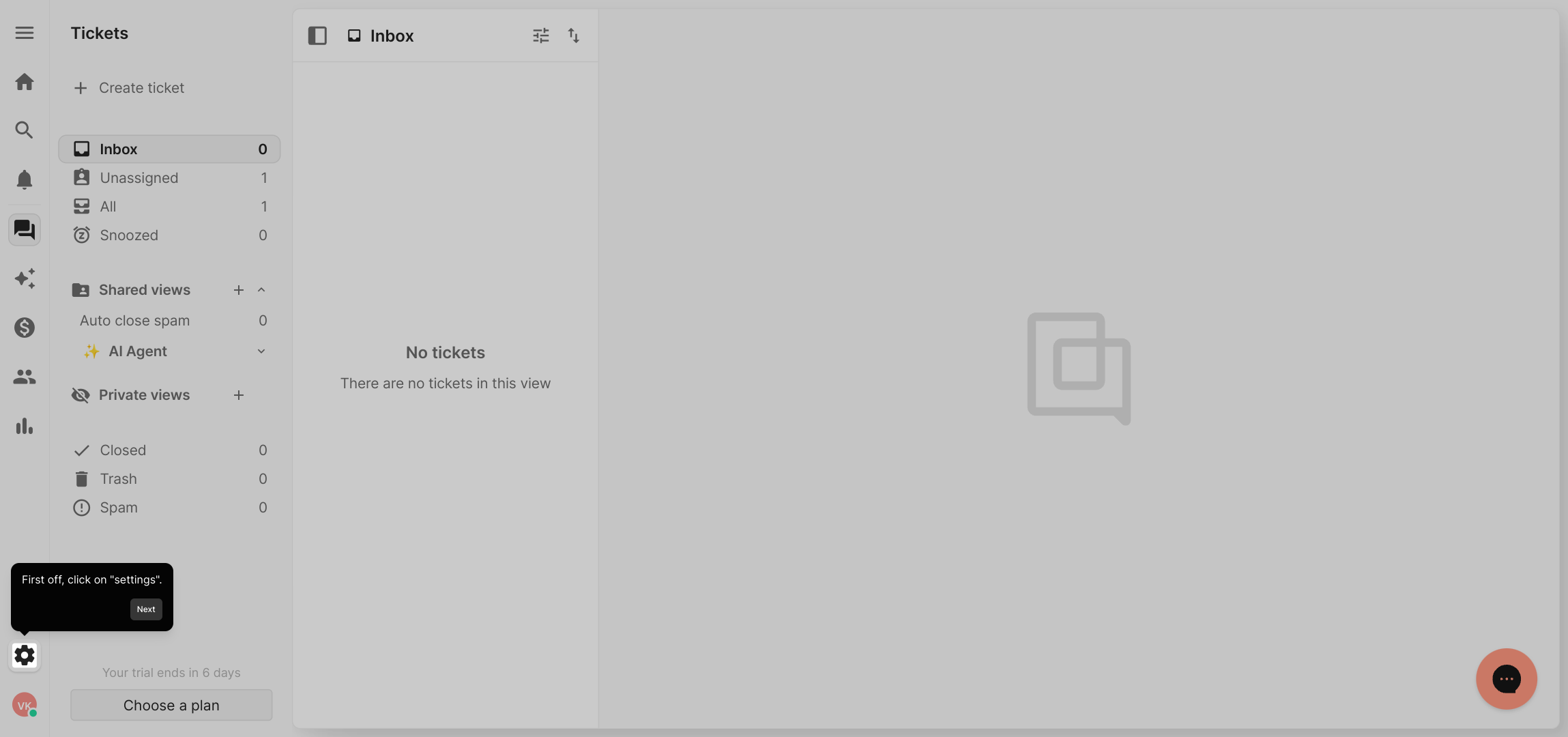1. First off, click on "settings".
2. Then, click on "HTTP integration".
3. Next up, click on "Add HTTP Integration".
4. After, add a name to the Integration.
5. Following that, add the Triggers.
6. Next, enter the URL to pass the ticket IDs.
7. Now, add the HTTP Method.
8. Then set the Response content type.
9. You can add headers by clicking here.
10. Once done, click on "Add integration".
11. Create a Supademo in seconds
This interactive demo/guided walkthrough on How to Build Custom HTTP Integrations for Gorgias was created using Supademo.
How to Build Custom HTTP Integrations for Gorgias : Step-by-Step Guide
To get started, locate the "Settings" option in the main menu of your dashboard and select it. This area allows you to configure various aspects of your account and integrations.

Within the settings panel, find and click on "HTTP Integration." This section is where you can manage and create external connections to automate communication between systems.

Next, look for the button labeled "Add HTTP Integration" and select it. This will open the form where you can create a new HTTP integration tailored to your needs.

Give your new integration a clear and descriptive name so you can easily identify it later. This helps keep your integrations organized, especially if you have several running simultaneously.

Now, specify the triggers that will activate this integration. Triggers determine when the integration sends data or takes action, allowing you to customize its behavior based on your workflow.

Enter the URL endpoint where the ticket IDs should be sent. This is critical for ensuring the integration knows exactly where to direct the data for further processing.

Choose the appropriate HTTP method for your integration, such as GET or POST, depending on how the receiving server expects to handle the data.

Set the response content type so the system knows how to interpret the data returned from the server. This ensures your integration handles responses correctly.

If your request requires additional headers, such as authorization tokens or custom identifiers, you can add them here by clicking the indicated section.

Once you have filled in all the necessary details, confirm and save your integration by clicking on the “Add integration” button to activate it.

Congratulations! Your HTTP integration is now set up, allowing you to create powerful automated workflows seamlessly with Supademo in just a few moments.

Create your own interactive demos in < 5 mins with Supademo
You can create your own interactive product demo in minutes using Supademo. Drive growth, scale enablement, and supercharge product-led onboarding with Supademo. Sign up for free here with no credit card required.
FAQs
What is a custom HTTP integration in Gorgias?
A custom HTTP integration in Gorgias connects your helpdesk to external services using HTTP requests, allowing automated workflows such as sending ticket data or triggering events on other platforms.
How do I add triggers to my HTTP integration?
Triggers are selected during the integration setup under "Triggers." They define when the integration fires, such as on ticket creation, update, or specific events within Gorgias.
Which HTTP methods are supported for integrations?
Gorgias supports common HTTP methods like GET, POST, PUT, and DELETE. Choose based on how your external endpoint expects to receive or handle data.
Can I add custom headers to my HTTP integration requests?
Yes, you can add custom headers such as authorization tokens or content-type headers within the integration setup, allowing secure and accurate communication with external APIs.
What should I enter as the URL in the HTTP integration?
Enter the endpoint URL of the external system where ticket IDs or data will be sent. Ensure this URL is publicly accessible and configured to receive your HTTP requests.
How do I handle response content types in integrations?
Set the response content type to specify how Gorgias interprets returned data (e.g. JSON or XML). This helps process responses correctly and trigger next steps if needed.
Is there a way to test my HTTP integration before going live?
While Gorgias does not have a built-in test mode, you can test your endpoint with tools like Postman or curl before setting up the integration, ensuring your server responds as expected.
Can custom HTTP integrations automate ticket management?
Yes, by triggering actions like updating tickets or notifying external applications, these integrations help automate support workflows and improve efficiency.
Are there usage limits for HTTP integrations in Gorgias?
Gorgias may apply rate limits to prevent abuse. Review your plan’s API and integration limits to ensure your HTTP requests stay within allowed thresholds for smooth operation.
Where can I find more help with building HTTP integrations in Gorgias?
Gorgias’ official documentation and support team are excellent resources. You can also explore community forums or contact Supademo for interactive demos to guide your setup.

